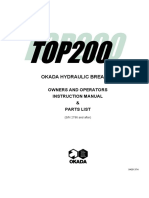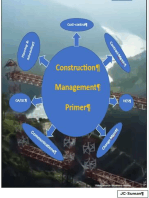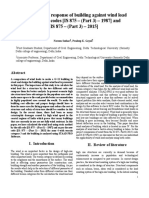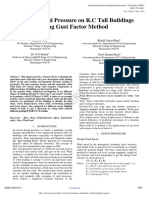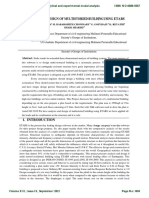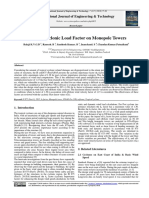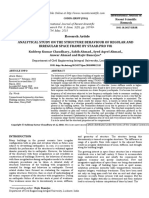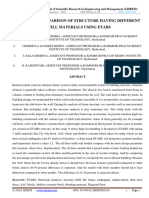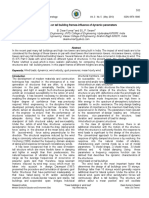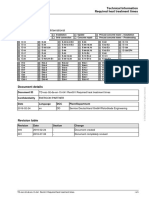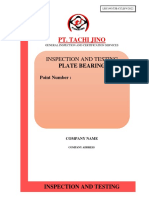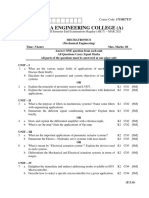A Literature Study of Wind Analysis On High Rise B
A Literature Study of Wind Analysis On High Rise B
Uploaded by
NILAY DEVCopyright:
Available Formats
A Literature Study of Wind Analysis On High Rise B
A Literature Study of Wind Analysis On High Rise B
Uploaded by
NILAY DEVOriginal Title
Copyright
Available Formats
Share this document
Did you find this document useful?
Is this content inappropriate?
Copyright:
Available Formats
A Literature Study of Wind Analysis On High Rise B
A Literature Study of Wind Analysis On High Rise B
Uploaded by
NILAY DEVCopyright:
Available Formats
See discussions, stats, and author profiles for this publication at: https://www.researchgate.
net/publication/329353175
A Literature Study of Wind Analysis on High Rise Building
Article · January 2018
DOI: 10.22161/ijaers.5.11.36
CITATIONS READS
3 298
2 authors:
Ashish Sadh Ankit Pal
Oriental University Oriental University
2 PUBLICATIONS 3 CITATIONS 26 PUBLICATIONS 43 CITATIONS
SEE PROFILE SEE PROFILE
Some of the authors of this publication are also working on these related projects:
A Review on use of Different Heights of Twin Towers High Rise Building View project
All content following this page was uploaded by Ankit Pal on 17 January 2020.
The user has requested enhancement of the downloaded file.
International Journal of Advanced Engineering Research and Science (IJAERS) [Vol -5, Issue-11, Nov- 2018]
https://dx.doi.org/10.22161/ijaers.5.11.36 ISSN: 2349-6495(P) | 2456-1908(O)
A Literature Study of Wind Analysis on High
Rise Building
Ashish Sadh1, Ankit Pal2
1 M. Tech Scholar Department of Civil Engineering, Oriental University, Indore, India
Email: ashishsadh001@gmail.com
2 Assistant Professor Department of Civil Engineering, Oriental University, Indore, India
Email: ankit.5792@gmail.co m
Abstract— Recently modern architecture means helpful which is to produce power and gives relief in hot
something regularity and irregularity in geometry. and humid environment and second one is parasitic which
Everyone wants to win the race of designing beautiful and comes out to be factor believe for engineers. As a
complex structures and with issue of scarcity of land it is designer engineer wants to be safe his structure This wind
today’s necessity to go higher and higher vertical a nd effect will cause and produce wind induce movement in
construct high rise structures. But as we go higher wind the structure. As high rise buildings move onward the
excitation becomes one of the most precarious force envelope to larger heights, the structural designers are not
acting on the surface of the structure and if the plan only faced with difficulty to choosing a structural
geometry is irregular it can induce torsion which can be elements to take the lateral load such as wind load and
life-threatening to the structure, so it is essential to earthquake load but also insuring the design criteria that
analyze and understand such forces during designing. In meets reliability and serviceability requirement under
this study the behavior of high rise building against the difficult wind environment.Wind load take action as
wind force in wind zone 2nd, L shape is studied and lateral weight on buildings which is act as along and
analyzed for specific heights.Also direction of wind plays across wind. In IS Code 875 (Part3)-1987, the basic wind
very vital role in behavior of structure. speed are specified in map and categorized by zones. The
Keywords— Wind pressure, High rise Structure, L shape and size of building is very significant in wind
shape geometry, Residential Building, Stress. analysis, because the wind pressure is mainly depends on
the exposed area of building in opposition to wind speed .
I. INTRODUCTION
In India residents are increasing gradually and the II. LITERATURE SURVEY
necessary land for living. It is a key requirement to Arvind Y. Vyavahare1, Godbole. P.N2, Trupti
survive anywhwere.For that reason multi story building Nikose3, 2012, As author study that Tall buildings are
are best choice for construction in Metro cities where a slender flexible structures in nature and require to be
smaller amount of property is presented. As designer examine to settle on the significance of wind speed
knows multi story structure provides large floor area in induced excitation along and across the path of wind in
small area and it is beneficial also . hence, it is required specific zone . The Indian codal provision of practice for
to assemble high rise structure. If high rise structures are wind load on any buildings and structures (code IS-875
constructed than many structural troubles come to pass, Part-3 1987) gives a procedure to determine along wind
such as lateral load effect, lateral displacement and response of tall structures, while the across wind response
stiffness etc. Normally for high rise structure wind and and intervention effect are not included in the code at
earth quake load effects are prevailing. Therefore for high present. A article ‘Review of Indian Wind Code IS 875
rise structure it is essential to have knowledge of different (Part 3) 1987’ has been set by IIT Kanpur under GSDMA
loads and its effect on structure. There is many type of project gives recommendations to gain across wind
effect worked on structure and causes for failure.The reaction of tall buildings and structure as per process
effect of lateral load is very important to consider such as given in Australian/New Zealand standard ‘Structural
earthquake and wind loads. In some cases the wind load is Design Actions – Part 2 Wind Action (AS/NZS 1170-2 :
important than earthquake load which depends on place 2002) In the Australian codal provision to obtain the cross
and zone factor distinct by codes. Wind load or wind wind response it is necessary to compute the coefficient
effect is as dangerous as earthquake as previous study (Cfs) for which figures and expressions are specified for
say. Defining wind there are two aspects first one is selected (h:b:d) ratios. In this paper use of Artificial
www.ijaers.com Page | 263
International Journal of Advanced Engineering Research and Science (IJAERS) [Vol -5, Issue-11, Nov- 2018]
https://dx.doi.org/10.22161/ijaers.5.11.36 ISSN: 2349-6495(P) | 2456-1908(O)
Neural Network (ANN) has been made to generalize the to successfully design a tall building which is not only
above process from the limited available data, so that stable, safe and strong under wind loads but also performs
across wind response can be obtained for a building with excellently providing usable and highly functional design.
given (h:b:d) ratio. Umakant Arya1, Aslam Hussain2, Waseem Khan3.
Shaikh Muffassir ¹,L.G. Kalurkar ², 2016, This study (2014),
shows The high rise structure or building is the necessity In this study paper, the investigative result of wind speed
of metro cities. The multi story high rise RC building are and structural response of building frame on sloping
more large and less elastic in nature as judge against to ground has been studied and analyze. Considering various
compound structures. This study investigates the frame geometries and slope of grounds. Combination of
similarity or comparison between RCC and composite static and wind loads are considered. There is many type
structure under the effect of wind, additional to it of sloping ground. For combination, 60 cases in different
compound structure also includes unlike plan wind zones and three different heights of building frames
configurations. this study has total 15 number of building are analyzed. STAAD-Pro software has been used for
model are arranged and analysis for wind load by using analysis purpose. Results are collected in terms of Storey-
ETABS 2015software. The various software are work on wise drift ,Shear force, moment, axial force, support
wind and earthquake analysis but we goes for software reaction, and Displacement which are critically analyzed
ETABS 2015.The wind analysis is performed for unlike to count the effects of a variety of slope of ground.
heights such 20m, 50m and 80m respectively. In adding K.R.C. Reddy1 (2015) In different type of high rise
together, the comparative study concludes that the structure chimney has its own importance. Along wind
compound structure are bigger elas tic in nature and more analysis of tall reinforced concrete chimneys by casual
at risk as compare to RCC structure and the compound vibration approach and Codal methods of India (IS 4998
option is better than RCC for multi story structure. Whole (part 1)), America (ACI 307) and Australia (AS/NZS
study is observed in software analysis.In addition, the 1170.2) are offered in this paper. For the analysis based
comparison of unlike plan configuration shows that the on casual vibration approach, the RC chimney is model as
response of parameter such as story displacement, story multi-degree-of freedom system subjected to static load
stiffness, base reaction and time period under effect of due to mean constituent of wind pace and dynamic load
wind. The reason of this analysis is to conclude the most due to changeable component of speed. The changeable
efficient shape of construction in horizontal zone. component of wind speed at a point is careful as temporal
N. Lakshmanan, S. Gomathinayagam*, P. random process. subsequently, the codal procedures for
Harikrishna, A. Abraham and S. Chitra Ganapathi, along-wind analysis of tall RC chimneys from Indian,
2009, Long-term data on hourly wind speed from 70 American and Australian codes are reviewed. Four RC
meteorological centres of India Meteorological chimneys are analyzed using these methods to achieve
Department have been collected. The daily gust wind data their responses. It is found that the codal methods of
have been processed for annual upper limit wind speed (in along-wind analysis are basic, are not prepared to
kmph) for each site. Using the Gumbel probability paper estimation the deflection of the chimneys and producing
approach the intense value quantiles have been derived. A mixed results. The simplifying assumptions used in these
design basis wind speed for each site for a return period codes are discussed.
of 50 years has also been evaluated. The sitespecific
changes in the design wind speeds in the contemporary III. EXPECTED OUTCOMES AND NEED OF THE
wind zone map for the design of buildings/structures are STUDY
highlighted and revision to the map issuggested.. The wind analysis on multi-storey building in wind zone
Tharaka Gunawardena1*, Shiromal Fernando 2, second, the structures situated in indore (m.p.).The main
Priyan Mendis 1, Bhathiya Waduge 2, Dilina purpose of this study is to analyse the highest multistory
Hettiarachchi 2, 2017, Urban habitats around the world building in Indore.
are becoming more congested with rising populations and Analyzing different building with their different
the need for tall buildings is as high as ever. Sri Lanka is height for wind analysis
experiencing this reality at present as Colombo’s skyline To determine various results for high rise
expands rapidly with a large number of upcoming building after the wind forces applied.
complex high-rise buildings. The response of tall The comparative study of different number of
buildings to wind forces is a critical design criterion and it RCC and composite structures.
requires both conventional force based designs as well as
performance based solutions. This paper discusses these
challenges and the engineering solutions that they require
www.ijaers.com Page | 264
International Journal of Advanced Engineering Research and Science (IJAERS) [Vol -5, Issue-11, Nov- 2018]
https://dx.doi.org/10.22161/ijaers.5.11.36 ISSN: 2349-6495(P) | 2456-1908(O)
IV. PROBLEM FORMULATION AND OBJECTIVE Journal of Academia and Industrial Research (JAIR)
The performance of RC structures before and after the ISSN: 2278-5213.
application of wind forces.. In this study we are [6] Ravinder Ahlawat and Ashok K. Ahuja, (2015),
introducing new and the highest building of the indore for “Wind loads on ‘Y’ plan shape tall building”.
get better performance of building during the wind.the International Journal Of Engineering and Applied
study to be done in wind zone second and the highest Sciences (IJEAS) ISSN: 2394-3661.
building in the region is the uniqueness of the study. [7] Md. Rashedul Kabir, Debasish Sen, Md. Mashfiqul
The specific aims and objectives of the project can thus be Islam, (2015), “Response of multi-storey regular and
mentioned as: irregular buildings of identical weight under static
a. Analysis of wind on G+19 storied RC and dynamic loading in context of Bangladesh”.
Residential building as per IS codal provided International Journal Of Civil and Structural
with different shapes . Engineering, ISSN 0976 – 4399
b. Analysis of wind G+19 storied RC Residential [8] Jawad Ahmed, H S Vidyadhar,“Wind Analysis and
building with different stories. Design of Multi Bay Multi Storey 3D RC Frame”,
c. Analysis of wind G+19 storied RC Residential International Journal of Engineering Research &
building story drift , base reaction and Technology (IJERT), ISSN: 2278-0181.
displacement [9] Hossein Moravej, Mahdi Hatami, Reza
Naghshbandi, Yaser Mousavi Siamakani , “W ind
V. CONCLUSION load analysis of buildings in hill-shape zone”, Int.
On performing the extensive survey of the literature available Journal of Applied Sciences and Engineering
n building structure it can be concluded that due to a wide Research, Vol. 4, Issue 1, 2015.
variety of buildings, the in depth understanding in the field of [10] Indian standard codal 875: part 2,3,5- 1987, “Code
wind Analysis and design of building structures is inadequate. of practice for Design loads (other than earthquake)
The IS codes has provided certain guideline on the basis of for buildings and structures.”
which the building structures can be designed when subjected [11] Indian standard codal 456: 2000, “Indian Standard
to wind loads. The literature survey in the performance and code of practice for general structural use of plain
behavior of building structures when subjected to wind loads and reinforced
suggests that the requirement of establishing a methodology [12] D.R. Panchal and P.M. Marathe, Comparative Study
for studying the response of building structure to winded loads of RCC, steel and composite (G+30 storey) building,
has become essential. Many researchers has performed work Institute Of Technology, Nirmal University,
over various types of building. on the different types of Ahmadabad, December,
buildings and find out the important parameter which is useful [13] Abhay Guleria, Structural Analysis of a Multi story
for understanding the behavior of wind forces. buildings using ETABS for Different plan
configuration, International journal of engineering
REFERENCES research and technology.
[1] Syed Fahad Ali and S.A. Bhalchandra, Study on [14] Mahesh Suresh Kumawat and L.G.Kalurkar,
seismic Analysis of RCC and steel-concrete Analysis and design of multi story building using
composite structure and cost comparison with composite structure, International Journal of
different support condition, International journal for Research in Engineering and Technology,3(2),
scientific research and development, [15] Codal provision IS: 875(Part 3)-1987, Indian
[2] Sanhik Kar Majumder and Priyabrata Guha, Standard Code of Practice for Design loads (other
Comparison between wind and seismic load on than Earthquake) for Buildings and Structures,
different types of structures,International journal of Bureau of Indian Standards, New Delhi..
engineering science invention [16] Ming Gu,“Study on wind loads and responses of tall
[3] U.Y.Jeong, Advance in tall building design under buildings and structures”The Seventh Asia-Pacific
strong winds, Structural congress ASCE, 2015 Conference on Wind Engineering, Nov.
[4] Code IS: 456(2000), Indian Standard Code of 2009,Taipei, Taiwan.
Practice for Plan and Reinforcement concrete [17] J. A. Amin and A. K. Ahuja (2008), “Experimental
(Fourth Revisions), Bureau of Indian Standards study of wind pressures on irregular plan shape
(BIS), New Delhi. buildings”. BBAA
[5] Ravinder Ahlawat and Ashok K. Ahuja, (2015), [18] International Colloquium on: Bluff Bodies
“Wind loads on ‘T’ plan shape tall buildings”. Aerodynamics & Applications Milano, Italy.
www.ijaers.com Page | 265
View publication stats
You might also like
- Google Cloud Partner Advantage Program Guide I Y24Document42 pagesGoogle Cloud Partner Advantage Program Guide I Y24androtaz13No ratings yet
- Manual de Partes Okada TOP200 (2796-) 040513THDocument56 pagesManual de Partes Okada TOP200 (2796-) 040513THHarold Marcano100% (1)
- Honeywell DVM R700 Network and Security Planning Guide v3Document187 pagesHoneywell DVM R700 Network and Security Planning Guide v3cristhian alfonsoNo ratings yet
- Managing Customer Consignment InventoryDocument68 pagesManaging Customer Consignment InventoryHimansu PalNo ratings yet
- A Literature Study of Wind Analysis On High Rise BDocument4 pagesA Literature Study of Wind Analysis On High Rise BDesign StudioNo ratings yet
- 36 ALiterature PDFDocument3 pages36 ALiterature PDFIJAERS JOURNALNo ratings yet
- AAK SAR SeismicWindAnalysisofMultistoryBuilding AReviewDocument4 pagesAAK SAR SeismicWindAnalysisofMultistoryBuilding AReviewAshok PandaNo ratings yet
- Review On Seismic Performance of RC Structure by Considering Different Orientation and Classes of BuildingDocument8 pagesReview On Seismic Performance of RC Structure by Considering Different Orientation and Classes of BuildingIJRASETPublicationsNo ratings yet
- IJCRT2208267Document14 pagesIJCRT2208267BeauTech Engg. & Construction Pvt. Ltd.No ratings yet
- Comparison of Response of Building Against Wind Load As Per Wind Codes (IS 875 - (Part 3) - 1987) and (IS 875 - (Part 3) - 2015)Document1 pageComparison of Response of Building Against Wind Load As Per Wind Codes (IS 875 - (Part 3) - 1987) and (IS 875 - (Part 3) - 2015)KNo ratings yet
- Effect of Wind Pressure On R.C Tall Buildings Using Gust Factor Method IJERTV3IS070871Document9 pagesEffect of Wind Pressure On R.C Tall Buildings Using Gust Factor Method IJERTV3IS070871Khushroo LankerNo ratings yet
- Comparative Study On Wind Analysis of Multi-Story RCC and Composite Structure For Different Plan ConfigurationDocument8 pagesComparative Study On Wind Analysis of Multi-Story RCC and Composite Structure For Different Plan ConfigurationMazen Al-arsanNo ratings yet
- Review On Seismic Analysis of High Rise Building With Is-16700-2017Document3 pagesReview On Seismic Analysis of High Rise Building With Is-16700-2017Anonymous Qm0zbNkNo ratings yet
- JETIRPaper - CFD Analysis of Wind Flow Behavior Around Tall Stacks: A ReviewDocument4 pagesJETIRPaper - CFD Analysis of Wind Flow Behavior Around Tall Stacks: A Reviewdineshadwani1911No ratings yet
- Study of Comparison Between Static and Dynamic Analysis Subjected To Wind and Earthquake LoadDocument6 pagesStudy of Comparison Between Static and Dynamic Analysis Subjected To Wind and Earthquake LoadAnonymous kw8Yrp0R5rNo ratings yet
- Seismic Analysis of High-Rise Buildings (G+30) by Using ETABSDocument9 pagesSeismic Analysis of High-Rise Buildings (G+30) by Using ETABSHema Chandra Reddy KarimireddyNo ratings yet
- Analysis of Tall Building For Across Wind ResponseDocument8 pagesAnalysis of Tall Building For Across Wind Responsepradeepjoshi007No ratings yet
- Effect of Building Shape On The Response To Wind and EarthquakeDocument7 pagesEffect of Building Shape On The Response To Wind and EarthquakeanoopNo ratings yet
- Behaviour of R.C.C. Tall Buildings Having Different Shapes Subjected To Wind LoadDocument5 pagesBehaviour of R.C.C. Tall Buildings Having Different Shapes Subjected To Wind LoadRiyaz SiddiqueNo ratings yet
- Along and Across Wind Loads Acting On Tall BuildingsDocument6 pagesAlong and Across Wind Loads Acting On Tall Buildingsfharak patelNo ratings yet
- Wind Design Loads On High-Rise Reinforced Concrete Buildings in Maysan Province Southern IraqDocument22 pagesWind Design Loads On High-Rise Reinforced Concrete Buildings in Maysan Province Southern IraqMunkh-Erdene TseveenNo ratings yet
- Comparative Analysis of Lateral Loads Resisting System For RCC StructureDocument9 pagesComparative Analysis of Lateral Loads Resisting System For RCC StructureIJRASETPublicationsNo ratings yet
- CEPM Volume2 Issue1 Pages1-16Document17 pagesCEPM Volume2 Issue1 Pages1-16Arya Univetsal MumbaiiNo ratings yet
- Along and Across Wind Loads Acting On Tall Buildings PDFDocument6 pagesAlong and Across Wind Loads Acting On Tall Buildings PDFShyamontika Choudhury ChakrabartiNo ratings yet
- Comparison of Seismic Zone-II & Zone-V With Respect To Wind Effects On High Rise Structure Using ETABSDocument8 pagesComparison of Seismic Zone-II & Zone-V With Respect To Wind Effects On High Rise Structure Using ETABSIJRASETPublicationsNo ratings yet
- Percentageof Reinforcementinthe Structurefor Various Seismic Zonesby Using ETABSDocument8 pagesPercentageof Reinforcementinthe Structurefor Various Seismic Zonesby Using ETABSAshu ArshadNo ratings yet
- Prem Synosis WLDocument3 pagesPrem Synosis WLmanojvn2468No ratings yet
- Shape Effects On Wind Induced Response of Tall Buildings Using CFDDocument7 pagesShape Effects On Wind Induced Response of Tall Buildings Using CFDSiti Rohani IsdrisNo ratings yet
- Analysis and Design of Multistoried Buildingusing EtabsDocument9 pagesAnalysis and Design of Multistoried Buildingusing EtabsDharma banothuNo ratings yet
- Investigation of Linear Dynamic Analysis and Duc-Tile Design of High Rise Structure As Per Revised Indian CodeDocument12 pagesInvestigation of Linear Dynamic Analysis and Duc-Tile Design of High Rise Structure As Per Revised Indian CodeIJRASETPublicationsNo ratings yet
- Paper EhsanDocument11 pagesPaper EhsanPrabesh ShresthaNo ratings yet
- Ijet 21807Document10 pagesIjet 21807db NiranjanNo ratings yet
- Research Article Analytical Study On The Structure Behaviour of Regular and Irregular Space Frame by Staad - Pro V8IDocument6 pagesResearch Article Analytical Study On The Structure Behaviour of Regular and Irregular Space Frame by Staad - Pro V8Ipp3986No ratings yet
- Seismic Analysis and Design of G+9 RCC Residential Building in STAAD - PRO For Zone II RegionDocument6 pagesSeismic Analysis and Design of G+9 RCC Residential Building in STAAD - PRO For Zone II RegionHen8No ratings yet
- Wind and Seismic Analysis of Pre-Engineered BuildingDocument10 pagesWind and Seismic Analysis of Pre-Engineered BuildingIJRASETPublicationsNo ratings yet
- Research Paper On ROTUNDADocument5 pagesResearch Paper On ROTUNDAIJRASETPublicationsNo ratings yet
- Wind Analysis of RCC Tube in Tube Structure Using ETABS SoftwareDocument13 pagesWind Analysis of RCC Tube in Tube Structure Using ETABS SoftwareIJRASETPublicationsNo ratings yet
- Effect of Wind Speed On Structural Behaviour of Monopole and Self-Support Telecommunication TowersDocument18 pagesEffect of Wind Speed On Structural Behaviour of Monopole and Self-Support Telecommunication TowersJaime Valente Morales BazalduaNo ratings yet
- Sar 121Document6 pagesSar 121digvijay singhNo ratings yet
- Project With MTHDLG 2-1Document14 pagesProject With MTHDLG 2-1Rohit chikkodiNo ratings yet
- Study On Seismic Analysis of High-Rise Building by Using SoftwareDocument9 pagesStudy On Seismic Analysis of High-Rise Building by Using SoftwaremonaliNo ratings yet
- Pushover Analysis of RCC Framed StructurDocument23 pagesPushover Analysis of RCC Framed StructurGleizel AutorNo ratings yet
- Comparative Study of Different Plan Configuration Buildings Using Wind AnalysisDocument9 pagesComparative Study of Different Plan Configuration Buildings Using Wind AnalysisRohit NegiNo ratings yet
- Comparative Analysis of Composite Structure by STADD Pro SoftwareDocument6 pagesComparative Analysis of Composite Structure by STADD Pro SoftwareIJRASETPublicationsNo ratings yet
- Design and Analysis of (G+4) Residential Building Using ETABSDocument7 pagesDesign and Analysis of (G+4) Residential Building Using ETABSIJRASETPublicationsNo ratings yet
- Analysis and Design of Elevated Intze Watertank and Its Comparative Study in Different Wind Zones - Using SAP2000Document12 pagesAnalysis and Design of Elevated Intze Watertank and Its Comparative Study in Different Wind Zones - Using SAP2000IJSTENo ratings yet
- Effect of Wind Speed On Structural Behaviour of Monopole and Self-Support Telecommunication TowersDocument18 pagesEffect of Wind Speed On Structural Behaviour of Monopole and Self-Support Telecommunication TowersANAND c mNo ratings yet
- 38 IJAERS APR 2019 33 TwinTowerDocument6 pages38 IJAERS APR 2019 33 TwinTowermd zamanNo ratings yet
- 23 Ijmtst060465Document8 pages23 Ijmtst060465Vesper ConstructionNo ratings yet
- Review On Comparative Analysis of SymmetricalDocument9 pagesReview On Comparative Analysis of SymmetricalIJRASETPublicationsNo ratings yet
- Effect of Wind Loads On High Rise Building in Different Seismic ZonesDocument6 pagesEffect of Wind Loads On High Rise Building in Different Seismic ZonesIRJMETS JOURNALNo ratings yet
- Across Wind Response - Aerodynamic, Gust, Matlab, All Useful Terms PDFDocument8 pagesAcross Wind Response - Aerodynamic, Gust, Matlab, All Useful Terms PDFKhushroo LankerNo ratings yet
- Analytical Modelling of T-Shaped Monolithic & Independent RCC BuildingsDocument8 pagesAnalytical Modelling of T-Shaped Monolithic & Independent RCC BuildingsIJRASETPublicationsNo ratings yet
- Study and Comparison of Structure Having Different Infill Materials Using ETABSDocument47 pagesStudy and Comparison of Structure Having Different Infill Materials Using ETABSnarsimha.m107No ratings yet
- Design of A Lattice Wind Tower and A Comparison of The Structural Response With and Without A TMDDocument23 pagesDesign of A Lattice Wind Tower and A Comparison of The Structural Response With and Without A TMDkarlrossmannNo ratings yet
- Final Article 1Document7 pagesFinal Article 1Ashok PandaNo ratings yet
- CFDmodellingofwindflowaroundbuildingsforwindenergyconversion Page10 EECB 12Document11 pagesCFDmodellingofwindflowaroundbuildingsforwindenergyconversion Page10 EECB 12puthenkulamNo ratings yet
- Analysis of G+30 Highrise Buildings by Using Etabs For Various Frame Sections in ZoneIV and ZoneV PDFDocument15 pagesAnalysis of G+30 Highrise Buildings by Using Etabs For Various Frame Sections in ZoneIV and ZoneV PDFK.ANISHNo ratings yet
- IJCIET Research IitDocument6 pagesIJCIET Research IitEdu4civil EngineeringNo ratings yet
- Wind LoadDocument5 pagesWind LoadAnjuNo ratings yet
- Analysis and Design of Commercial Building With Different Slab Arrangements Using ETABSDocument6 pagesAnalysis and Design of Commercial Building With Different Slab Arrangements Using ETABSronald torresNo ratings yet
- Introduction to Design of Building StructuresFrom EverandIntroduction to Design of Building StructuresRating: 4 out of 5 stars4/5 (22)
- Lecture 5 Stand-Up Report IIDocument35 pagesLecture 5 Stand-Up Report IImei chee punNo ratings yet
- TD Esc 02 de en 15 041 Rev001 Required Heat Treatment TimesDocument3 pagesTD Esc 02 de en 15 041 Rev001 Required Heat Treatment TimesFelipe SilvaNo ratings yet
- Risk Analysis and Prediction of The Stock Market Using Machine Learning and NLPDocument6 pagesRisk Analysis and Prediction of The Stock Market Using Machine Learning and NLPAkash GuptaNo ratings yet
- The Multitarget Application ModelDocument30 pagesThe Multitarget Application ModelA BachhawatNo ratings yet
- Management Trainee at Darwinbox JDDocument3 pagesManagement Trainee at Darwinbox JDKamna SrivastavaNo ratings yet
- Aircraft Engine Performance Parameters: Propulsive EfficiencyDocument8 pagesAircraft Engine Performance Parameters: Propulsive EfficiencyEby P HenryNo ratings yet
- What Is The Real Impact of Social MediaDocument3 pagesWhat Is The Real Impact of Social MediaKevinDanyVeraVillanuevaNo ratings yet
- UR15 SDR MO ParameterDocument600 pagesUR15 SDR MO Parameterhimu_050918No ratings yet
- Bearing Plate Report TemplateDocument6 pagesBearing Plate Report TemplateFrans ManurungNo ratings yet
- Engineering Mathematics-1Document8 pagesEngineering Mathematics-1Ali Mehdi RizviNo ratings yet
- 06 8:27 Am Page 1 Shur-Lift HydraulicDocument49 pages06 8:27 Am Page 1 Shur-Lift HydraulicHtun LinnNo ratings yet
- Industrial-VentilationDocument93 pagesIndustrial-Ventilationahmed mahmoudNo ratings yet
- Lego 1Document11 pagesLego 1A. S Ahmed sohailNo ratings yet
- !indx PipDocument18 pages!indx PipCharles JacobNo ratings yet
- Resume SampleDocument3 pagesResume SampleNilesh RautNo ratings yet
- Activity Completion Report Template1 220330083707Document9 pagesActivity Completion Report Template1 220330083707Brian SantiagoNo ratings yet
- GD-SS EnseriesDocument12 pagesGD-SS Enseriesjuan felipe laiton rodriguezNo ratings yet
- Donny Widiyanto S.T: Contact Work ExperienceDocument7 pagesDonny Widiyanto S.T: Contact Work ExperiencevheNo ratings yet
- Hilbert Transformer: Dr. Salahedin RehanDocument11 pagesHilbert Transformer: Dr. Salahedin RehanMinimol RajNo ratings yet
- Pre-Delivery: Inspection ChecklistDocument8 pagesPre-Delivery: Inspection ChecklistShannon HutchinsonNo ratings yet
- Printing - Packaging - 65Document12 pagesPrinting - Packaging - 65EconaurNo ratings yet
- Godox LED6R 20210507Document1 pageGodox LED6R 20210507Ömer GezerNo ratings yet
- Wind Turbine Blade Design: Joseph Rand The Kidwind Project 877-917-0079Document18 pagesWind Turbine Blade Design: Joseph Rand The Kidwind Project 877-917-0079Ad Man GeTigNo ratings yet
- Aditya Engineering College (A)Document2 pagesAditya Engineering College (A)sri kumarNo ratings yet
- Student User ManualDocument6 pagesStudent User ManualSparsh ChopraNo ratings yet
- Java Fundamentals Section 5: Creating An Inventory Project Project SolutionDocument2 pagesJava Fundamentals Section 5: Creating An Inventory Project Project SolutionnaniNo ratings yet

